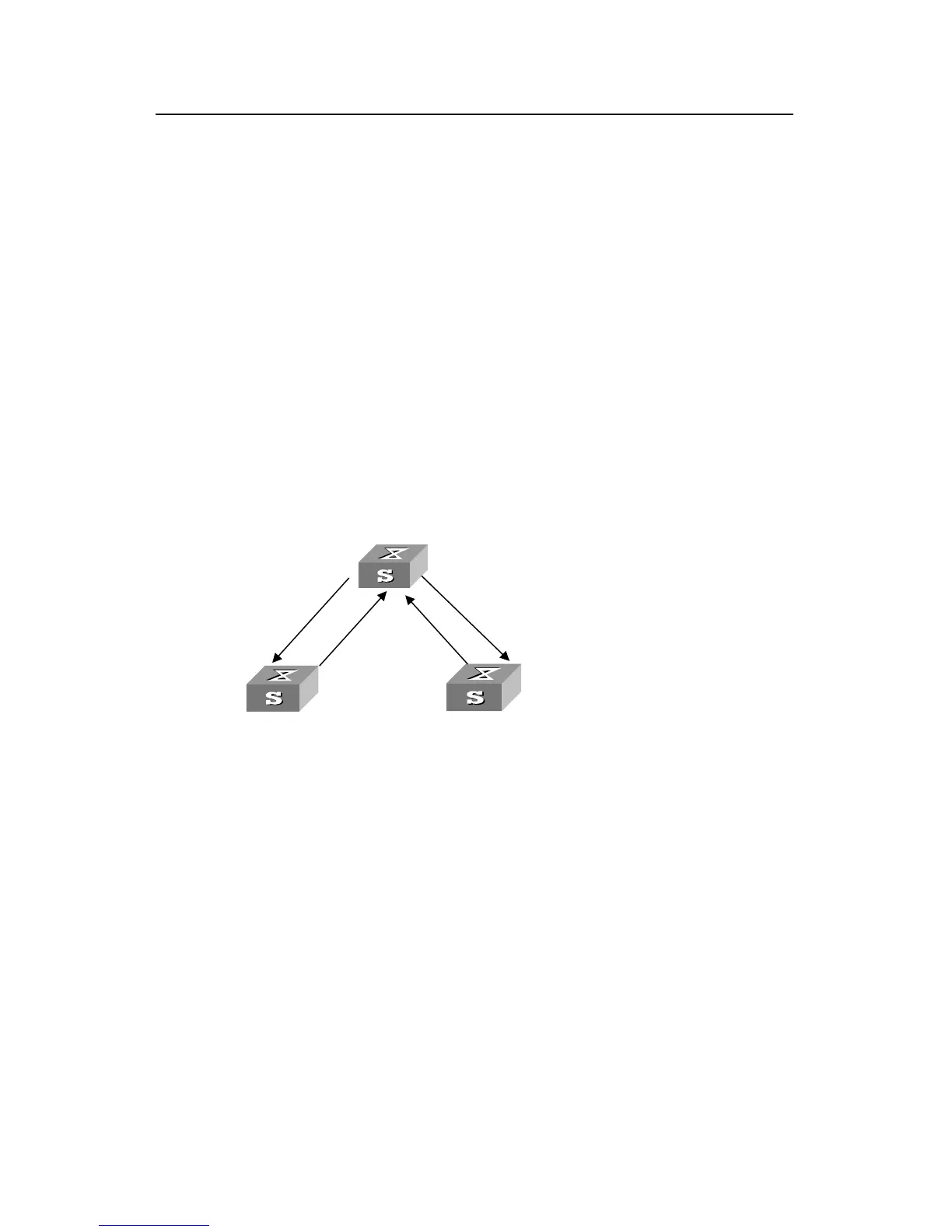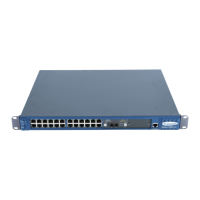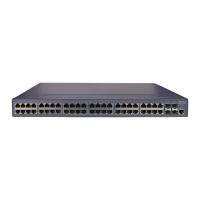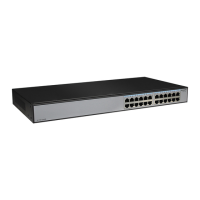Operation Manual - Integrated Management
Quidway S3000-EI Series Ethernet Switches Chapter 2
HGMP V2 Configuration
Huawei Technologies Proprietary
2-2
agement interface for all the switches in the cluster. The administrator device
z
by the administrator device’s command redirection. The member device
z
uster.
z Administrator device: Configured with a public network IP address and providing
man
manages the member device through command redirection, that is, administrator
device receives and processes the management commands from the network. If
the command is destined to a member device, the administrator device will
forward it to the member device. The administrator device has the functions such
as discovering adjacency information, collecting the topology of the whole network,
managing the cluster, maintaining the cluster status and supporting different
agents.
Member device: Member of a cluster, doesn’t assigned public IP address,
managed
has the functions such as discovering adjacent information, being managed by the
administrator device, executing the commands delivered by the proxy and
reporting failure/log etc.
Candidate device: Not a member of any cluster yet, but member-capable, that is,
being able to be a member device of a cl
The following figure illustrates the rules of role switchover.
Command switch Member switch
Candidate switch
R
em
ov
e fr
om
a
c
l
us
t
er
D
e
si
g
n
a
t
e
d
a
s
c
o
m
m
a
n
d
s
w
i
t
c
h
A
d
d
e
d
t
o
a
c
l
u
s
t
e
r
R
e
m
o
v
e
f
r
o
m
a
c
l
u
s
t
e
r
Candidate device
Command device Member device
R
em
ov
e fr
om
a
c
l
us
t
er
D
e
si
g
n
a
t
e
d
a
s
c
o
m
m
a
n
d
d
e
v
i
c
e
A
d
d
e
d
t
o
a
c
l
u
s
t
e
r
R
e
m
o
v
e
f
r
o
m
a
c
l
u
s
t
e
r
Candidate switch
Command switch Member switch
R
em
ov
e fr
om
a
c
l
us
t
er
D
e
si
g
n
a
t
e
d
a
s
c
o
m
m
a
n
d
s
w
i
t
c
h
A
d
d
e
d
t
o
a
c
l
u
s
t
e
r
R
e
m
o
v
e
f
r
o
m
a
c
l
u
s
t
e
r
Candidate device
Administrator device Member device
R
em
ov
e fr
om
a
c
l
us
t
er
D
e
si
g
n
a
t
e
d
a
s
a
d
m
i
n
i
s
t
r
a
t
o
r
d
e
v
i
ce
A
d
d
e
d
t
o
a
c
l
u
s
t
e
r
R
e
m
o
v
e
f
r
o
m
a
c
l
u
s
t
e
r
Candidate switch
Command switch Member switch
R
em
ov
e fr
om
a
c
l
us
t
er
D
e
si
g
n
a
t
e
d
a
s
c
o
m
m
a
n
d
s
w
i
t
c
h
A
d
d
e
d
t
o
a
c
l
u
s
t
e
r
R
e
m
o
v
e
f
r
o
m
a
c
l
u
s
t
e
r
Candidate device
Command device Member device
R
em
ov
e fr
om
a
c
l
us
t
er
D
e
si
g
n
a
t
e
d
a
s
c
o
m
m
a
n
d
d
e
v
i
c
e
A
d
d
e
d
t
o
a
c
l
u
s
t
e
r
R
e
m
o
v
e
f
r
o
m
a
c
l
u
s
t
e
r
Candidate switch
Command switch Member switch
R
em
ov
e fr
om
a
c
l
us
t
er
D
e
si
g
n
a
t
e
d
a
s
c
o
m
m
a
n
d
s
w
i
t
c
h
A
d
d
e
d
t
o
a
c
l
u
s
t
e
r
R
e
m
o
v
e
f
r
o
m
a
c
l
u
s
t
e
r
Candidate device
A
d
d
e
d
t
o
a
c
l
u
s
t
e
r
Administrator device Member device
R
em
ov
e fr
om
a
c
l
us
t
er
D
e
si
g
n
a
t
e
d
a
s
a
d
m
i
n
i
s
t
r
a
t
o
r
d
e
v
i
ce
R
e
m
o
v
e
f
r
o
m
a
c
l
u
s
t
e
r
Figure 2-2 Rules of changing roles
strator device configured for every cluster. The
entifies and discovers the Candidate device
z
z There must be a unique admini
designated administrator device id
through collecting NDP/NTDP information. You can configure a Candidate device
as a member device of the cluster.
After added to a cluster, the Candidate device becomes a member device. If a
member device is deleted from the cluster, it becomes a Candidate device again.

